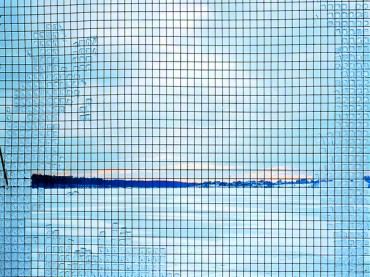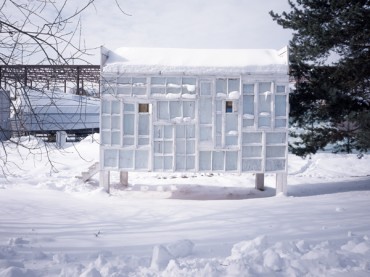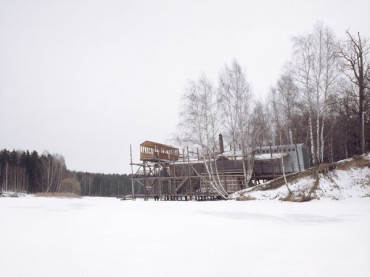Selected Topic
Issue 1 - After Crisis – Contemporary Architectural Conditions (Feb 2011)
Show articles
Ice Pavilion, Klyazminskoye Reservoir Resort, Alexander Brodsky, 2004

Ice Pavilion, Klyazminskoye Reservoir Resort, Alexander Brodsky, 2004

Ice Pavilion, Klyazminskoye Reservoir Resort, Alexander Brodsky, 2004

Vodka Ceremony Pavilion. Klyazminskoye Reservoir Resort. Alexander Brodsky 2004

Vodka Ceremony Pavilion. Klyazminskoye Reservoir Resort. Alexander Brodsky 2004

95º Restaurant, near Moscow, Alexander Brodsky 2001
4.7.2012 – Issue 1 - After Crisis – Brodsky Alexander – Essays
Everything is Temporary
Lecture by Alexander Brodsky
95º Restaurant was conceived as a structure of the kind that is widespread in Russia – a temporary waterfront building with an unclear purpose – either a shed, or a boardwalk, or a wharf, or all three combined. These buildings are often neglected and deserted: as soon as they are not used any more, they are abandoned and fall into decay. This dictated both the look and the material, and even the structural concept. The location is in a developing resort on the edge of a water reservoir near Moscow. The brief required a summer restaurant with a simple structure built with cheap materials. Thus, the choice was obvious: materials that are habitually used for temporary building in Russia – wood, plywood, perspex and galvanised steel.
The feeling of decay was obtained through the 5-degree inclination of the load-bearing columns toward the waterfront; hence the name of the restaurant. This inclination also linked the building to the leaning trees on the site. The structure of wooden beams was erected based on the single working model provided by the architect. The dining spaces are mostly open, except for a “banquette hall” located on the roof, in a rusted steel box with perspex walls, a few windscreens around the bar made of perspex as well, and the kitchen enclosed in a plywood box finished with galvanised steel with a glass brick window.
The brief was kept as standard as possible: the concept dictated using traditional, “ready-made” solutions, keeping the costs low and the design thorough. There was general acquiescence for the builders to stick with the regular methods of practice to attain the maximum level of realism. Nonetheless, many details were developed by the architects on site with regard towards a somewhat archetypical feeling of an old structure.
Everything is Temporary
Everything is temporary, even very strong structures are just temporary. Something built to last two months can be as temporary and as permanent as something built to stand for many years. Very often you see temporary things that are much stronger and much more important than some things that are meant to last forever. Most of the things I have made are temporary; also because I mostly used to work with very small budgets, getting commissions for very small things.
Somehow I like the spirit around temporary things and I am very often inspired by temporary structures.
95º Restaurant. Klyazminskoye Reservoir Resort. Alexander Brodsky 2001
Ceremony and Space
Ceremony is central to a couple of things I have made: the Vodka Ceremony Pavilion for instance. I invented both the building and the ceremony there: Two people step in, and stand at the two sides of the table. There is a basin of vodka and two cups chained to the table. The visitors pour the vodka into the cups and drink it saying toasts in rounds.
The project was commissioned as an installation for the ArtKlyazma 2003 art festival. It turned out to be an architectural statement, through the use of material and its cultural message. It is a simple spatial and material metaphor of the Russian “art de vivre”. This is a cultural recycling project, as second-hand building elements were reused with all their meaning and connotations being utilised in the new structure. Discarded window frames picked up at a demolition site in the centre of Moscow were fixed onto a simple wooden frame and painted white. Reused timber appears here as a universal medium for architecture and memory.
Vodka Ceremony Pavilion. Klyazminskoye Reservoir Resort. Alexander Brodsky 2004
With the Ice Pavilion, the entire initial construction and subsequent dismantling process is a kind of ceremony of appearing and disappearing. The temporary/permanent opposition is probably at its strongest in this project: temporary material on a temporary ice surface.
The Ice-bar was a seasonal pavilion on the ice of the Klyazminskoye reservoir. The objective was simply to provide drinks to the skaters and ice boaters on the ice of the lake in the winter, within the $500 budget. The structure consisted of a wooden frame wrapped in steel mesh, then sprayed with water, which immediately froze in the -15 C cold. I was highly interested in the moment the building is going to disappear. Many people came to see the pavilion when it was not there anymore. I received an important prize for this project in an architectural exhibition in Moscow. It was around the end of May, and they gave me the prize for the best built structure that had already disappeared; I thought that was highly symbolic.
Ice Pavilion.
Klyazminskoye Reservoir. Alexander Brodsky 2002
Drawing vs. Reality
Drawing is very important for me. It forms a really enormous part of the architectural process. Everything comes out of it; drawing is the initial idea, which is the most important thing. Even if the project doesn’t come to fruition, if it is not built, it is real because there is a drawing and it can be realised at any moment. Unbuilt projects are no less real than built projects: they exist in different ways.
For many years I produced only drawings. After more than twenty years I got the possibility of building something small. Of course, it was very important for me. I started with very simple things with very small budgets and I did not have a big choice; I had to choose the simplest, cheapest things to make my first pieces. That was during an important period in my country, when life changed so much with the introduction of the huge contrast between very rich projects for the oligarchs and things made with virtually no money.
Somewhere deep in my brain there was an idea that even without having much money one can build something useful, maybe good, using very simple, cheap materials.
Nostalgia
I do not yearn for some specific earlier period, but we all have nostalgic feelings about our childhood and youth. When I see some old things that remind me of my childhood, I have that feeling, and sometimes I want to use these old pieces to create something new from things from time gone by that will continue to exist now. It is a very simple combination and sometimes it works.
For me, it is not so much about the reuse of materials as giving new life to some beautiful old things. I often use objects that I come across for my art pieces. Sometimes I just happen to find something very nice on a rubbish dump, and then I use it for my installations. I see architecture as art, so for me it is normal to use discarded things that remind me of something important. I like to give them new life; maybe not a very long one, but still, they continue to speak to people for some time.
Dachas and anonymous buildings from Alexander Brodsky’s lecture at the Chair Josep Lluis Mateo, May 2010
Moscow
I do not hold out much hope for Moscow. I am very pessimistic about my city; too many things and opportunities have already been lost. What is happening in Moscow now is very painful for me. It is an enormous disaster.
Of course, all cities change, but the way Moscow is being changed is a real crime. The city has been being destroyed for many years. What used to be an amazingly beautiful city is disappearing at every moment. In another twenty years there will be nothing left to look at, except the Kremlin and a handful of churches. Entire neighbourhoods, beautiful nineteenth-century buildings and masterpieces from the early twentieth century are being destroyed to build new structures with underground parking that can be easily rented. The worse thing is that this is happening solely for money, and not because of certain, perhaps erroneous, but strong ideas. The only reason now is to line somebody’s pocket. It is almost impossible to build something there without being involved in some process of destruction, and I do not want to be anywhere near that.
I really respect Stalinist architecture. I think they were the last architectural pieces that actually made the city better, by adding something to the whole atmosphere. In Stalinist times, they demolished lots of small nineteenth century buildings which made up the city of Moscow, which was a pity, and they built the seven towers. But still, there is a special quality to this architecture, a kind of uniqueness specific to the place; it is Moscow architecture with, at least for me, some mystery about it.
In the new things that occasionally try to imitate it, there is no mysterious moment whatsoever.
Coma. Installation, Guellman Gallery, Moscow. Alexander Brodsky, 2000: “the city as a living creature lying on a surgery table”
From a lecture given at ETH Zurich, Chair of Prof. Dr. Josep Lluis Mateo
Download article as PDF

